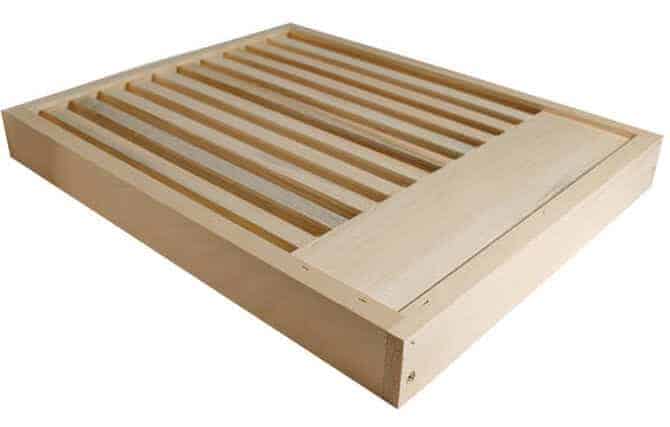Most beekeepers start out with a hive with standard components. The most common of these is the iconic Langstroth hive, with its bottom board, multiple boxes, inner cover and top cover.
Many beekeepers have been successful with this simple, direct way to house their bees. It’s a design that has lasted the test of time and continues today as the most popular of hive designs.
But beekeepers are always looking to improve on what they offer their bees. This manifests itself in the availability of a wide range of accessories and options, such as feeders, entrance reducers and more.
One such option is the slatted rack.

What is a slatted rack?
The slatted rack is a simple design – a bottom board-like wooden structure, with numerous slats (gaps) embedded within the body. Slatted racks sit on top of the traditional bottom board and underneath the lower box in the hive, namely the brood box.
The slatted rack has the same dimensions as the boxes and is a generally couple of inches deep. It is positioned such that the slats run parallel with the frames in the boxes above, for reasons we cover below.
Hive ventilation
Air is a poor conductor of heat. The slatted rack places a layer of air below the brood box, which can be beneficial in both summer and winter.
In the summer, the slatted rack can help the bees as they seek to regulate the temperature within the hive. Bees will gather in the space provided by the slatted rack, fanning their wings. As well as providing them with a greater space in which to fan air through the hive, these bees will be outside the main hive, which reduces congestion.
In winter, the space within the slatted rack provides an insulating layer, providing some protection from cold air flowing into the hive.
Reduction in swarming
Swarming occurs when bees run out of space. One supposed advantage of a slatted rack is that it expands the area within which bees can hang out and that may reduce the potential swarming.
While the extent of this benefit is sometimes debated, those who use slatted racks believe that this is an additional benefit of their use.
Number of slats and alignment
Many beekeepers use a screened bottom board, which is a tool in the beekeeper’s armory to help assess mite levels. This relies on the fact that a percentage of mites will naturally fall through the hive, onto the bottom board. A screened bottom board collects and retains these mites, which affords the beekeeper a way to assess the level of mites.
It is important when using a slatted rack that the slats run parallel with the frames above and have the same number (PerfectBee offers both 8 and 10 frame versions). This ensures mites can fall directly through and onto the bottom board, without collecting on the rack.
The slatted rack has a larger block of wood at one end, which should be installed such that it faces the front of the hive. This helps to calm the flow of air at this important area of the hive.
Shallow side up
The slatted rack has a shallow side and a deep side. It is important that the shallow side be facing upwards. This discourages workers from building comb from the slatted rack upwards to the lower edge of the brood chamber. This would cause problems when moving the brood chamber, such as when reversing brood boxes, for example.
Other advantages
In addition to the direct advantages associated with ventilation, another benefit relates to where the queen lays her eggs. In a traditional setup, without a slatted rack, the queen may stop laying her eggs at a certain point above the entrance to the hive, to ensure the brood can be kept at an appropriate temperature.
The insulation layer that results from the use of a slatted rack is considered to encourage the queen to lay closer to the lower edge of the frames in the brood box, hence expanding the usable area of these frames for egg-laying purposes.
Summary
Like a lot of beekeeping choices – such as the use of a smoker, the type of feeder, foundationless frames and even the type of hive – beekeepers draw their own conclusions and then tend to stick with them!
The use of slatted racks is another such choice. Many hobbyist beekeepers swear by them and install them in every hive they maintain. Their benefits are worthy of consideration by all beekeepers using Langstroth hives.
